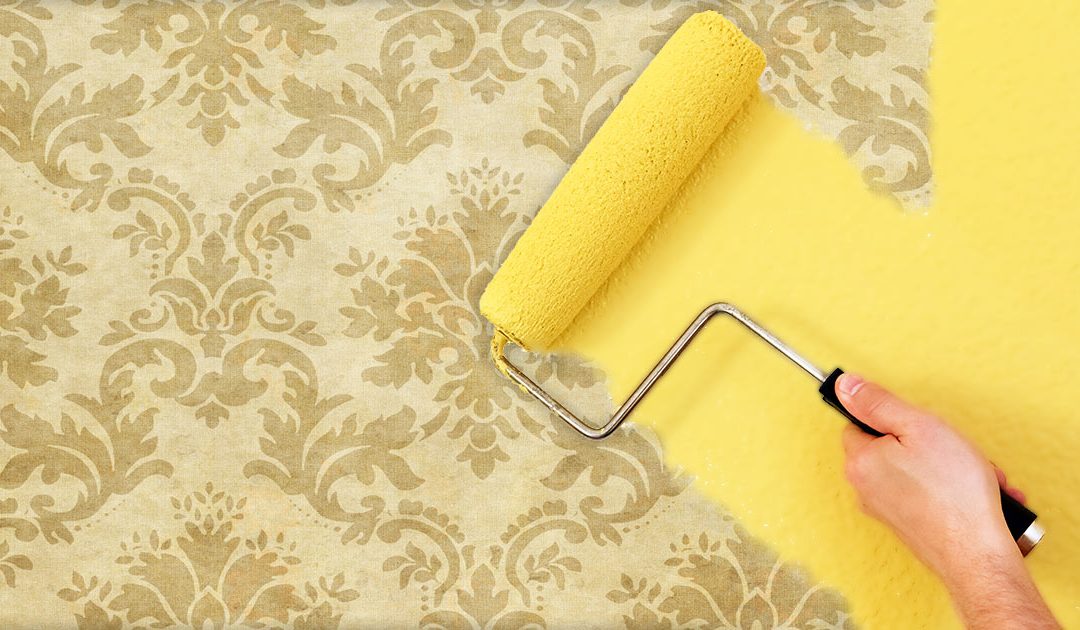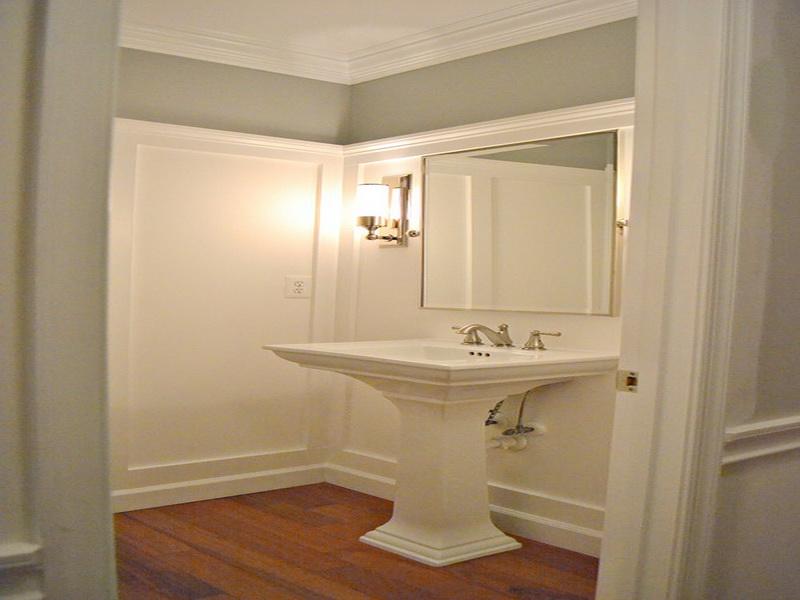The Feasibility of Painting Over Wallpaper in a Bathroom

Painting over wallpaper in a bathroom can be a tempting cost-effective way to refresh the space, but it’s crucial to consider the factors involved before embarking on this project.
Types of Wallpaper Suitable for Painting, Can you paint over wallpaper in a bathroom
Understanding the type of wallpaper you’re dealing with is paramount to determining whether painting over it is feasible. Not all wallpapers are created equal, and some are simply not designed to be painted.
- Vinyl-coated wallpaper: This type of wallpaper is commonly found in bathrooms due to its moisture resistance. It’s generally the most suitable for painting as the vinyl coating provides a smooth, even surface that paint can adhere to.
- Textured wallpaper: If the texture is fine and the wallpaper is made from a paintable material like vinyl or paper, painting over it is possible. However, if the texture is too pronounced, it may create an uneven surface that will show through the paint.
- Paper-backed wallpaper: This type is typically less durable and may not hold up well to the moisture and humidity of a bathroom environment. Painting over it is possible, but the results may be inconsistent and the wallpaper could become damaged over time.
Types of Wallpaper Unsuitable for Painting
While some wallpapers are designed for painting, others are not and should be removed before painting.
- Foil wallpaper: This type of wallpaper is known for its reflective surface and can be difficult to paint over, as the paint may not adhere properly.
- Fabric-backed wallpaper: This wallpaper type often has a textured surface and may not hold up well to the moisture and humidity of a bathroom environment. Painting over it is not recommended, as the paint may not adhere properly and the wallpaper could become damaged over time.
- Wallpaper with a glossy finish: Glossy finishes can make it difficult for paint to adhere properly. It’s best to remove this type of wallpaper before painting.
Preparing Wallpaper for Painting
Proper preparation is key to a successful painting project over wallpaper.
- Clean the wallpaper: Thoroughly clean the wallpaper with a damp cloth to remove dirt, grime, and any residue. Allow the wallpaper to dry completely before proceeding.
- Prime the wallpaper: Priming the wallpaper is essential for creating a smooth, even surface that paint can adhere to. Use a primer specifically designed for painting over wallpaper.
- Patch any holes or cracks: Before priming, use a spackling compound to fill any holes or cracks in the wallpaper. Allow the spackling compound to dry completely before priming.
Examples of Successful and Unsuccessful Painting Over Wallpaper Projects
- Successful Example: A homeowner painted over vinyl-coated wallpaper in their bathroom using a primer designed for painting over wallpaper. They achieved a smooth, even finish that looked great and lasted for years.
- Unsuccessful Example: A homeowner attempted to paint over fabric-backed wallpaper in their bathroom. The paint did not adhere properly, and the wallpaper became damaged over time. The homeowner eventually had to remove the wallpaper and repaint the walls.
Preparing the Bathroom for Painting: Can You Paint Over Wallpaper In A Bathroom

Painting over wallpaper in a bathroom requires careful preparation to ensure a smooth and long-lasting finish. This process involves removing loose wallpaper, cleaning the walls, and protecting the bathroom fixtures and floor.
Removing Loose Wallpaper
Removing loose or peeling wallpaper is crucial before painting. This prevents the wallpaper from bubbling or peeling under the new paint.
- Use a wallpaper scraper to gently loosen the edges of the wallpaper.
- Apply a wallpaper remover solution to the wallpaper, allowing it to penetrate for the recommended time.
- Carefully peel off the wallpaper, working in small sections.
- For stubborn wallpaper, use a steamer to loosen the adhesive.
- Once the wallpaper is removed, use a damp cloth to clean any remaining adhesive residue.
Cleaning the Walls
Cleaning the bathroom walls thoroughly is essential to remove dirt, grime, and mildew, which can prevent the paint from adhering properly.
- Use a mild detergent and warm water to wash the walls, paying attention to areas with mildew or soap scum.
- Rinse the walls thoroughly with clean water and allow them to dry completely before painting.
- For stubborn mildew, use a mildew-killing solution according to the manufacturer’s instructions.
Protecting the Bathroom Fixtures and Floor
Protecting the bathroom fixtures and floor during the painting process is important to prevent paint splatters and spills.
- Cover the bathtub, shower stall, toilet, and sink with drop cloths or plastic sheeting.
- Use painter’s tape to protect the edges of fixtures and trim.
- Cover the bathroom floor with drop cloths or a plastic tarp to protect it from paint spills.
The Painting Process

Now that your bathroom is prepped, it’s time to get painting! Painting over wallpaper can be a bit trickier than painting bare drywall, but with the right approach, you can achieve a smooth, professional finish.
Choosing the Right Paint
Selecting the appropriate paint is crucial for a successful and durable bathroom paint job. Bathroom walls are exposed to moisture, humidity, and frequent cleaning, so using a paint formulated specifically for these conditions is essential.
- Acrylic Latex Paint: This is the most common type of paint for bathrooms. It’s water-based, dries quickly, and is mildew-resistant. Acrylic latex paints also offer good adhesion, making them suitable for painting over wallpaper.
- Epoxy Paint: Epoxy paints are highly durable and moisture-resistant, making them ideal for areas prone to heavy wear and tear, such as shower stalls or tub surrounds. However, they can be more challenging to apply and may require professional installation.
- Oil-Based Paint: While oil-based paints offer excellent durability and water resistance, they are not as environmentally friendly as latex paints and require mineral spirits for cleanup. They are also less common for bathroom painting due to their slower drying time and strong odor.
Painting Techniques for a Smooth Finish
Proper painting techniques are essential for achieving a professional-looking finish. Here are some tips for applying paint evenly and avoiding brushstrokes:
- Use a High-Quality Brush or Roller: A good brush or roller will help you apply paint smoothly and evenly. Look for brushes with soft bristles and rollers with a nap that’s appropriate for the texture of your walls.
- Thin the Paint: Adding a small amount of water to your paint can help it flow more smoothly and prevent brushstrokes. However, be careful not to thin it too much, as this can compromise the paint’s coverage and durability.
- Apply Thin Coats: Multiple thin coats of paint will provide better coverage and a smoother finish than one thick coat. Let each coat dry completely before applying the next.
- Use Long, Even Strokes: When applying paint, use long, even strokes to minimize brushstrokes. Overlap each stroke by about 50% to ensure complete coverage.
- Smooth Out Any Imperfections: If you notice any brushstrokes or uneven areas, use a damp sponge or roller to smooth them out before the paint dries completely.
Tips for a Professional Finish
Here are some additional tips for achieving a professional-looking finish:
- Prepare the Surface: Thoroughly clean the wallpaper with a damp cloth to remove any dirt or grime. Allow it to dry completely before painting.
- Use Painter’s Tape: Protect trim, moldings, and fixtures with painter’s tape to prevent paint from getting on them. Apply the tape carefully to ensure a clean line.
- Use a Primer: A primer will help the paint adhere better to the wallpaper and provide a smoother finish. Choose a primer specifically designed for use over wallpaper.
- Work in Sections: Paint in manageable sections, such as one wall at a time. This will help you keep track of your progress and prevent the paint from drying too quickly.
- Let the Paint Dry Completely: Allow the paint to dry completely before applying a second coat. The drying time will vary depending on the type of paint and the temperature and humidity of the room.
Can you paint over wallpaper in a bathroom – While you can paint over wallpaper in a bathroom, it’s essential to ensure the surface is clean, smooth, and properly prepared. Kilz makes excellent primers specifically designed for bathrooms, providing a strong foundation for your chosen paint color. To find the perfect shade for your bathroom, check out this guide to Kilz bathroom paint colors , offering a range of options to complement your style and create a beautiful and functional space.
Once you’ve selected your color, you’ll be ready to give your bathroom a fresh, new look.
Painting over wallpaper in a bathroom can be a great way to refresh the space, but it’s important to consider the type of wallpaper and the condition of the surface. If you’re thinking about a basement bathroom, choosing the right paint color can really make a difference in the overall feel of the space.
Check out this guide to basement bathroom paint colors for inspiration. Once you’ve chosen your paint, you can start prepping the wallpaper by cleaning it thoroughly and applying a primer to ensure the paint adheres properly.